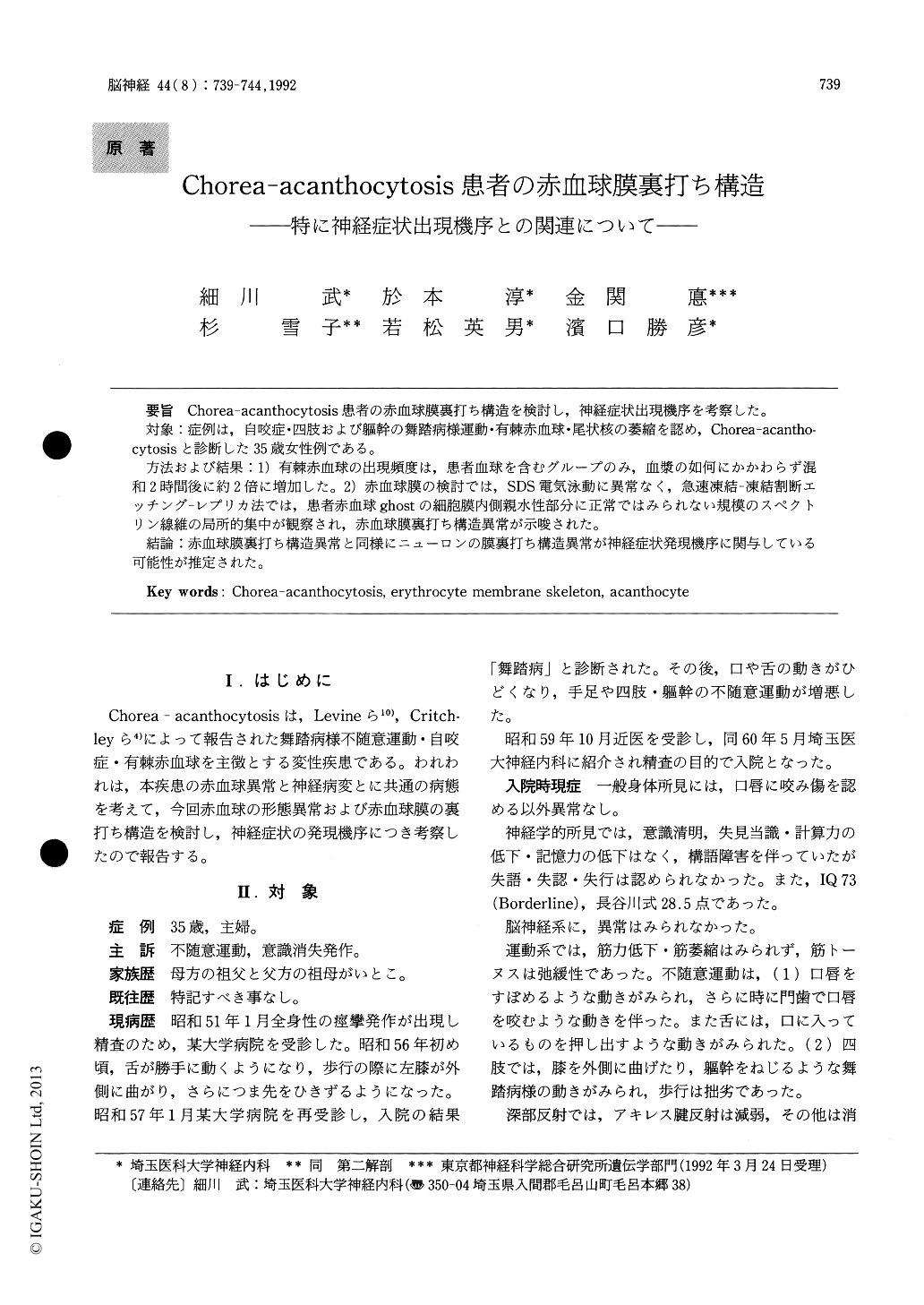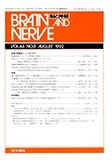Japanese
English
- 有料閲覧
- Abstract 文献概要
- 1ページ目 Look Inside
Chorea-acanthocytosis患者の赤血球膜裏打ち構造を検討し,神経症状出現機序を考察した。
対象:症例は,自咬症・四肢および躯幹の舞踏病様運動・有棘赤血球・尾状核の萎縮を認め,Chorea-acantho—cytosisと診断した35歳女性例である。
方法および結果:1)有棘赤血球の出現頻度は,患者血球を含むグループのみ,血漿の如何にかかわらず混和2時間後に約2倍に増加した。2)赤血球膜の検討では,SDS電気泳動に異常なく,急速凍結—凍結割断エッチングーレプリカ法では,患者赤血球ghostの細胞膜内側親水性部分に正常ではみられない規模のスペクトリン線維の局所的集中が観察され,赤血球膜裏打ち構造異常が示唆された。
結論:赤血球膜裏打ち構造異常と同様にニューロンの膜裏打ち構造異常が神経症状発現機序に関与している可能性が推定された。
Patients with chorea-acanthocytosis exhibit symptoms of self-biting, choreic movement, and acanthocytosis, but not dementia. The mechanism of choreic movements is still unknown. In order to clarify the etiologic mechanism underlying these movements, we evaluated the erythrocyte mem-brane in one patient with chorea-acanthocytosis.
A 35-year-old female was admitted to Saitama Medical School Hospital because of involuntary movements. She was alert, well-oriented, and had no gross memory defects. She had slurred speech, choreic movements and lip biting. Laboratory examination showed acanthocytes in her peripheral red blood cells, normal serum lipid values, and caudate atrophy on her brain CT scan.
In analyzing the acanthocytes, we initially evaluated the size of the acanthocyte population by incubating her red blood cells with plasma. The cell population approximately doubled after 2 hours incubation.
Next we examined the protein composition of erythrocyte ghost by sodium dodecyl sulfate poly-acrylamide gel electrophoresis (SDS-PAGE) . There was no significant difference between the patient's erythrocyte ghosts and those of a control.
Then we investigated morphological changes in the patient's erythrocyte by scanning and transmis-sion electron microscopy (SEM and TEM). SEM showed the typical acanthocyte shape. The quick-freeze, freeze-substitution method confirmed that the routine TEM section was not artifactual, and was in fact in accurate reflection of the actual features of acanthocytes. TEM of the sections prepared from erythrocyte ghosts demonstrated that spectrin tended to be accumulated in the thorn region. Furthermore, TEM of quick-freeze, deep-etched replica of the ghost revealed more clearly aspectrin network densely packed on the inner hydro-philic surface. These changes might correspond to morphological changes in the erythrocyte.
Recent progress in research on spectrin-related molecules, brain spectrin and other molecules have demonstrated these molecules in neuronal cells of the mammalian brain. Post - mortem histopatho-logical study in patients with this disease have demonstrated neuronal cell loss in the caudate and putamen nuclei.
From these facts, we can speculate that the morphological changes seen in erythrocytes and the neuronal cell loss were induced by the same under-lying mechanism in this disease.

Copyright © 1992, Igaku-Shoin Ltd. All rights reserved.


